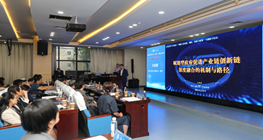Context-Driven Innovation Column
Xu Hui,Zhou Qi
With the advancement of the digital economy, context-driven innovation, as a new innovation paradigm, has become a key path to create new technologies, new products, new channels, new business models and even open up new markets and new areas. The trend of context-driven innovation has made a considerable impact on the original business model in the industry, and the service innovation practice of enterprises has been injected with new context-driven elements, and solutions that meet customer-specific value propositions have become a key path for enterprises to increase their potential for value creation, and it promotes context application as a powerful tool for product innovation and business model innovation for enterprises. For this reason, many high-tech enterprises have shifted to provide solution business, build context-driven solutions based on the characteristics of fissionable growth of emerging context, and create new personalized experiences and context values for customers by exploring the integration point of new technologies with context and new ways of product interaction design.#br#Context-driven solutions involve a new service business model based on context application and context value construction to respond to customer needs. It follows the basic logic of using context value building to gain insight and explore customer needs, and being forward-looking to provide customers with surpassing service expectations, thus realizing the transformation of technological advantages into business value. Although existing research has focused on context-driven solutions as a new feature of context-driven enterprise service innovation model, the value co-creation logic of helping customers to complete "to-do tasks" based on the value insight of context-driven solutions has not been fully explained, and the understanding and deconstruction of context-driven solutions still needs to be further deepened.#br#In order to figure out how enterprises develop context-driven solutions, this paper selects four enterprises, namely, Hikvision, iFLYTEK, Neusoft and Inspur, as case study objects, deconstructs the inner law of context-driven solution development and builds a theoretical model. It is found that, first, context-driven solution development has the key feature of context-driven, which is mainly manifested in two dimensions of context penetration and context coverage. Second, under the context-driven approach, enterprises develop context-driven solutions based on the realization path of "requirement identification—technology integration—service operation and maintenance". Specifically, enterprises transforming into context-driven solution providers follow the realization path of "forward-looking requirement identification-technology external integration-exploratory service operation and maintenance", while natural context-driven solution providers follow the realization path of "responsive requirement identification-technology internal integration- exploitative service operation and maintenance". Third, data enabling is the endogenous driving force of context-driven solution development, and it can facilitate the transition between the development of context-driven solutions such as requirements identification, technology integration, and service operation and maintenance.#br#The theoretical contributions of this paper lie in three aspects. First, this study combines context theory and customer solution theory, and innovatively proposes a new model for enterprises to carry out service value creation in the era of digital intelligence, that is, the new concept of context-driven solution. It identifies the context-driven solution's context-driven characteristics that distinguish it from customer solutions in a general sense, which enriches the theoretical cognition of context-driven solutions, and contributes to deepening the understanding of the context-driven service innovation model. Second, unlike previous studies on the development process of customer solutions, this paper focuses on the deconstruction of the inner laws of the context-driven solution development process. By refining the realization path and endogenous driving of context-driven solution development, it complements the theoretical gap caused by the lack of discussion on the logic of context-driven solution development in existing research. Third, this paper introduces the concept of data enabling into the exploration of context-driven solution development process. By identifying data enabling as the endogenous driving of context-driven solution development, the study enables a more theoretically inclusive analysis of the role of "data actors" in context-driven solution development, providing a new analytical perspective to clarify the inner workings of solution development. Moreover, it provides a paradigm reference for enterprises to effectively embed technological advantages into the development process of new scenarios, inspiring enterprises to develop their capabilities following changes in the policy environment, industry technology environment and customer needs.#br#
